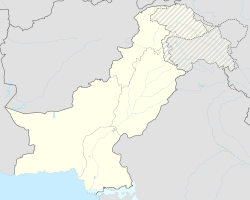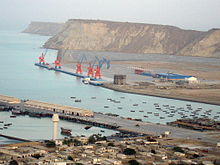Gwadar
|
Gwadar گوادر |
||
| State : |
|
|
| Province : | Balochistan | |
| Coordinates : |
25 ° 8 ' N , 62 ° 19' E
|
|
| Area : | 570 km²
|
|
| Residents : | 264,000 (2018) | |
| Population density : | 463 inhabitants per km² | |
| Time zone : |
PST ( UTC + 5 )
|
|
|
|
||
Gwadar ( Urdu گوادر) is a Pakistani port city with around 264,000 inhabitants.
location
Gwadar is located about 475 km west of Karachi on the Arabian Sea in the south-west of the country in the desert region of Makran , which belongs to Balochistan . Turbat , the capital of Makran, is about 220 km northeast.
The city of Gwadar is located on a low, sandy and elongated peninsula that protrudes south into the sea, which is also called Gwadar and, over the millennia, between the mainland coast and an offshore, 13 km long and up to 3 km wide rock plateau, the up to 137 m high Koh-e-Batil, was washed up. The hammer-shaped peninsula has an area of 570 km² and forms two semicircular bays in its west and east, the Paddi Zirr (West Bay) and the Deymi Zirr (East Bay).
climate
Gwadar has a desert climate and there is almost no precipitation all year round (average annual temperature 26.2 ° C, average annual precipitation 106 mm). The highest amount of rain ever measured within 24 hours was 227 mm on June 6, 2010 in the wake of cyclone Phet .
| Gwadar | ||||||||||||||||||||||||||||||||||||||||||||||||
|---|---|---|---|---|---|---|---|---|---|---|---|---|---|---|---|---|---|---|---|---|---|---|---|---|---|---|---|---|---|---|---|---|---|---|---|---|---|---|---|---|---|---|---|---|---|---|---|---|
| Climate diagram | ||||||||||||||||||||||||||||||||||||||||||||||||
| ||||||||||||||||||||||||||||||||||||||||||||||||
|
Average monthly temperatures and rainfall for Gwadar
Source: de.climate-data.org
|
||||||||||||||||||||||||||||||||||||||||||||||||||||||||||||||||||||||||||||||||||||||||||
Residents
The population is overwhelmingly made up of Baluchi from different tribes (Hoots, Gihckis, Kauhdas, Meers, Kalmati, Dashti and Rind), and the predominant language is Baluch . There is an old center of the Ismaili community in Gwadar . The Ismailis play a central role in the city and local society.
history
The region around today's Gwadar was inhabited by an unknown people during the Bronze Age who settled in some oases . Later the area became the province of Gedrosien of the Persian Achaemenid Empire . Presumably it was conquered by Cyrus II . During the conquests of Alexander the Great , his admiral Nearchus sailed with a fleet along the coast of what is now Makran. He described the area as dry and mountainous where the Ichthyophagoi ( fish eaters ) live. Their name is the Greek translation of the old Persian " Mahi khoran ", from which the current name of the Makran region is derived. After the collapse of the Alexander Empire, the region was ruled by Seleucus I , one of Alexander's generals. From 303 B.C. The region was ruled by Chandara Gupta Moria and other local rulers. At times the city was home to pirates .
In 711 Muhammad bin Qasim conquered Gwadar with an Arab - Muslim army. Other conquerors such as the Mughal Empire and the Safavids followed later . Gwadar played an important role early on in the trade in slaves, spices and ivory between the Indian Ocean and Central Asia . In the 16th century, the Portuguese failed in their attempt to conquer the city due to resistance from the Kalmat tribe . After that, local Baluch tribes ruled the area for almost 200 years .
In 1783 Mir Nasir , the Khan of Kalat , transferred sovereignty over Gwadar to Sultan ibn Ahmad of the Omani Said dynasty , who had fled Muscat after a dispute over the throne with his brother . After Sultan ibn Ahmad retook Muscat, he retained control of Gwadar and transferred the rule to a governor ( wali ). This was commissioned to subjugate the coastal city of Chah Bahar , which is located near what is now Iran . The fortress was built in Gwadar during the time of the Omani rule. The Oman was 1891 British protectorate. Gwadar remained part of Oman when the surrounding area gained independence from the United Kingdom as Pakistan in 1947.
On September 8, 1958, Oman handed the Gwadar exclave to Pakistan after Aga Khan III. had paid three million pounds for it. Gwadar became part of the Balochistan Province on July 1, 1977 after a transition period .
port
prehistory
From March 2002, under Chinese leadership, an oil and container deep-sea port was built in the East Bay of Gwadar under the protection of the rocky plateau , which is the first port in Pakistan to be suitable for all sizes of ships. Pakistan expects economic development for the entire region and relief from Karachi as the main trading port. In 2007 the new port was officially opened. The construction had cost a billion US dollars by then. China itself had invested $ 200 million. In 2004 and 2006 a total of six Chinese engineers were murdered by Baloch insurgents. In 2010 the entire complex was completed.
In addition to the port, an industrial area and a motorway connecting Gwadar with the rest of the country are also planned. So far there is only one road from Gwadar, the Makran Coastal Highway (N 10), through mostly inhospitable desert over a distance of 630 km to Karachi. China is also building a new airport. Extensive housing developments are planned on the rock plateau.
In 2007, the Pakistani government granted Gwadar a 40-year free port status and transferred port management to PSA Singapore ; since 2013 the port has been managed by a Chinese company.
Strategic importance of the port
Gwadar is located at the entrance to the Persian Gulf, from where much of the world's oil supplies come. So far, sixty percent of China's oil imports have to be transported by ship from the Persian Gulf to Shanghai over a distance of more than 16,000 kilometers. The journey takes two to three months and is also exposed to various risks such as piracy and bad weather. In the future, China's western central Asian provinces can be supplied with oil and other raw materials from Arabia and Africa overland from Gwadar. Thus, the western provinces of China can transport their goods via roads partly built by China and embark via Gwadar. In addition, a natural gas pipeline leads from the Central Asian “ stan states ” to Gwadar and thus enables the onward transport of natural gas by sea. Here Gwadar is in direct competition with Iranian ports.
Another important factor is the possibility for the Navy of the People's Republic of China to use this port as a base . The close proximity to rival India plays a decisive role here, as does the fact that Gwadar is only around 400 kilometers from the Strait of Hormuz , which is important for the world's energy supply . The border with Iran is just 60 kilometers away. The national road 10 leads there from Gwadar. The port and the city of Gwadar were predicted to develop rapidly due to the excellent geopolitical location.
Web links
- Vision Gwadar (English)
- Gwadar News (English)
- Gwadar. In: SDNP Islamabad Pakistan. Archived from the original on April 23, 2008 .
- Tarique Niazi: Gwadar: China's Naval Outpost on the Indian Ocean. The Jamestown Foundation, February 16, 2005 (English).
- Ammad Hassan: Pakistan's Gwadar Port - Prospects of Economic Revival. (pdf, 791 kB) Naval Postgraduate School, June 10, 2005, archived from the original on March 8, 2006 (English).
Individual evidence
- ↑ DISTRICT AND TEHSIL LEVEL POPULATION SUMMARY WITH REGION BREAKUP (PDF) (English)
- ↑ Sangar Housing Gwadar. Retrieved August 11, 2016 .
- ^ District Development Profile: Gwadar. (PDF) Planning and Development Department of the Government of Balochistan in cooperation with UNICEF, 2011, accessed on August 11, 2016 .
- ↑ a b c d e Oman.org
- ^ Livius.org: "Gedrosia" by Jona Lendering
- ^ A b Vision Gwadar - Historical Perspectives
- ↑ Dott. Beatrice Nicolini: Oman Studies Center, "International trade networks: The Omani Enclave of Gwadar"
- ↑ Pakistan wants a Chinese naval base on its territory
- ↑ BBC, March 20, 2007, Pakistan launches strategic port
- ↑ Khaleeq Kiani, Dawn: 40-year tax relief for Gwadar port operators , February 2, 2007.
- ^ The News International: Gwadar port formally handed over to Chinese company of February 18, 2013, loaded May 5, 2015
- ↑ Archive link ( Memento of the original dated February 7, 2015 in the Internet Archive ) Info: The archive link was inserted automatically and has not yet been checked. Please check the original and archive link according to the instructions and then remove this notice.
- ↑ With cards open, Balochistan - Another Civil War? Broadcast on Arte on May 24, 2006 at 10:30 p.m.




